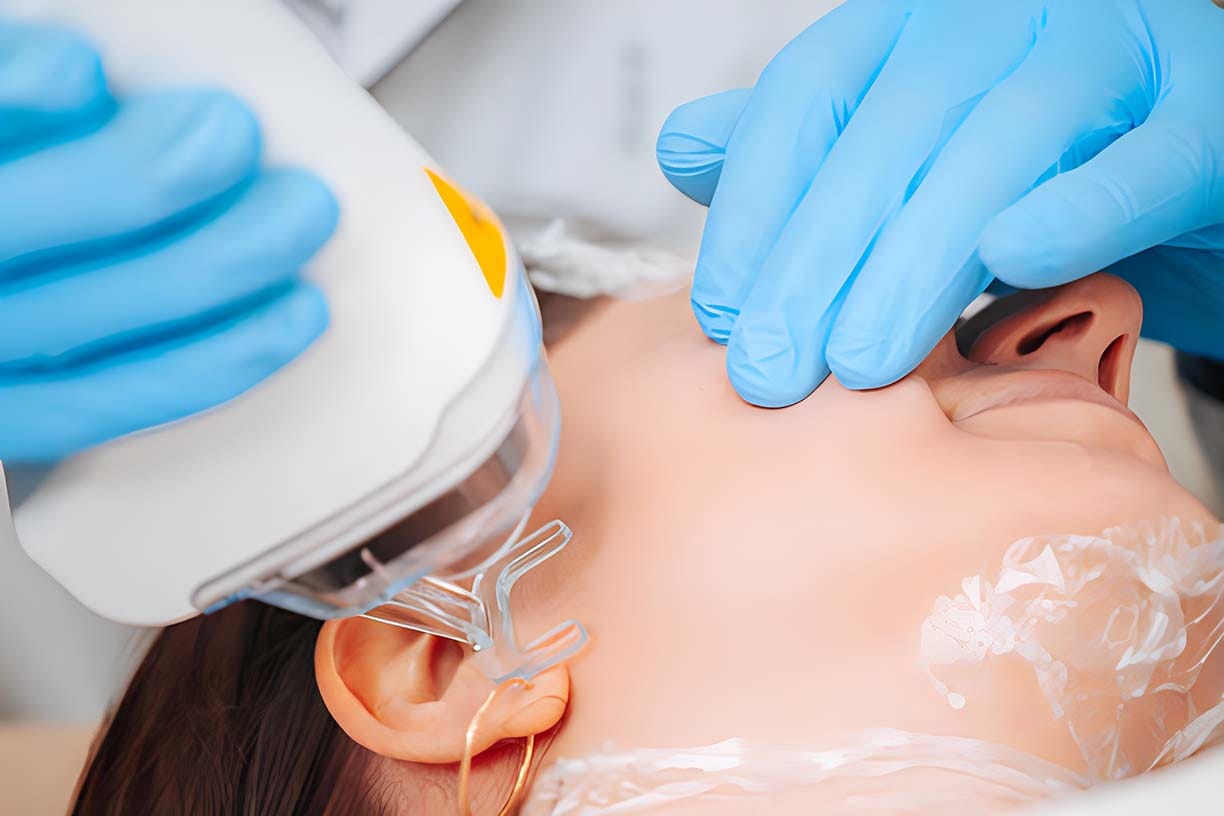This article is reviewed, corrected, and approved by: Dr. Benjamin McLean M.D. | FCPS | FRCP | MPH
Laser resurfacing is a popular cosmetic procedure that has helped many people achieve smoother, healthier-looking skin. Whether you're dealing with wrinkles, scars, or sun damage, laser resurfacing can be a game-changer.
What is Laser Resurfacing?
Laser resurfacing is an aesthetic procedure that utilizes laser technology to enhance the texture and look of your skin. Laser resurfacing is a legit way to deal with some skin problems. When it comes to wrinkles, acne scars, age spots, and uneven skin tone, there's nothing it can't handle.
Basically, it works by getting rid of damaged skin layers and making new collagen, which makes your skin smooth and younger.
Different Types of Laser Resurfacing?
When it comes to laser resurfacing, there are two main categories.
- CO2 Laser Resurfacing: CO2 laser resurfacing treats skin conditions like wrinkles, scars, warts, and birthmarks. Traditional or fractional CO2 lasers are used for this procedure.
- Ablative Laser Resurfacing: Laser treatment is an effective solution for treating skin issues. There's a lot of intense work involved, but the results are worth it.
- Nonablative Laser Resurfacing: Nonablative lasers work beneath the skin's surface. The outer layer doesn't get damaged while collagen is being produced.
Pros of Laser Resurfacing


The following are some of the benefits of laser resurfacing:
- Improved skin texture and tone.
- Wrinkle and fine line reduction.
- Scars can be made less noticeable.
- Fading of age spots and sun damage such as sun spots on skin.
- Boosted collagen production.
- Enhanced overall skin quality.
Risks and Side Effects of Laser Resurfacing
There are a number of risks and side effects associated with laser resurfacing, which should be taken into consideration before proceeding. These may include redness, swelling, itching, and temporary changes in skin color. It's important to choose a professional if you don't want scarring or infection.
Who is A Good Candidate for Laser Resurfacing?
Laser resurfacing is a viable option for individuals who present various skin concerns. This cosmetic procedure has proven effective for people who are generally in good health, possess realistic expectations, and do not smoke. However, it is imperative to engage in a thorough discussion with a qualified dermatologist or plastic surgeon to determine the suitability of this procedure for your individual case
Before the Procedure

- Consult with a dermatologist or surgeon: Your journey starts with a consultation to discuss your goals, assess your skin, and determine the most appropriate laser type.
- Medical history review: In order to ensure that the procedure is safe for you, your medical history will be reviewed.
- Pre-operative instructions: Please comply with the pre-operative instructions before your surgery, which may require you to refrain from certain medications and skincare routines.
- What to expect on the day of the procedure: Arrive for your appointment with clean, makeup-free skin, and be prepared for the treatment.
During the Procedure
The laser resurfacing procedure will depend on the type you choose:
- Ablative laser resurfacing: This involves the removal of thin layers of skin, which may require anesthesia for comfort.
- Nonablative laser resurfacing: This is a less invasive option and may not require anesthesia.
During the procedure, you may feel a warming sensation or mild discomfort, but it's generally well-tolerated.
After the Procedure
- Recovery and downtime: Expect some downtime, with recovery ranging few days to a week.
- Post-operative care instructions: Follow your provider's post-operative care instructions diligently, including skincare and sun protection.
- What to expect during the healing process: As your skin heals, you may experience redness, peeling, and swelling, which is entirely normal.
- When to expect results: Noticeable improvements often become apparent within a few weeks, but full results may take a few months to develop.
Case Studies
Before and after photos of laser resurfacing patients can provide visual evidence of the procedure's effectiveness, giving you a better idea of what to expect.
Final Thought
Laser resurfacing can make your skin look and feel amazing while giving you a confidence boost. When it comes to choosing between ablative and nonablative treatments, it all depends on what you're looking for and what you prefer. The most important thing is to have a chat with a qualified dermatologist or plastic surgeon.
They'll listen to your goals, offer expert advice, and help you decide if laser resurfacing is the right choice for you. The procedure's cost and potential insurance coverage will vary, so it's crucial to explore your options and make an informed decision. Lastly, always remember to follow post-operative care instructions to ensure a successful recovery and lasting results.
Additional Information
- Cost of laser resurfacing: The cost varies depending on factors like the provider's location and the extent of treatment.
- Insurance coverage for laser resurfacing: Insurance policies usually do not provide coverage for cosmetic treatments like laser resurfacing.
- Alternative treatments for skin resurfacing: If you're looking for other ways to take care of your skin, you might want to consider alternative treatments like chemical peels and microdermabrasion. These treatments can help with similar skin concerns.
- Consultation: When you go for your consultation, talk to your provider about these options.
FAQS
Q: What are the best products to use after laser resurfacing?
Ans: Your provider will recommend specific post-operative skincare products tailored to your needs, but typically, gentle cleansers, moisturizers, and sunscreen are essential.
Q: Are there ways to lower the risks of laser resurfacing?
Ans: Choose a qualified and experienced provider, follow pre-operative and post-operative instructions, and avoid sun exposure during the healing process to reduce the risk of complications.


